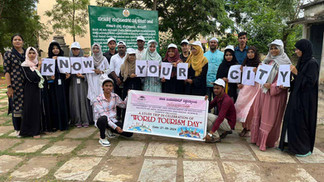Study Trip in Celebration of World Tourism Day
- barikhateeb
- Sep 27, 2024
- 3 min read
The Departments of Sociology and History, Faculty of Arts, Humanities and Social Sciences at Khaja Bandanawaz University, organized a study trip in commemoration of World Tourism Day. The event took place on September 27, 2024. As part of the trip, participants visited several historical and cultural sites, including the Khaja Bandanawaz Dargah, Haft Gumbad, the Government Museum, Buddha Vihar, and the Gulbarga Fort, providing a unique opportunity for students to explore and learn about the rich heritage of these locations.
Total Number of students and Staff Participated: Students 26 Staff members 05.
Introduction
In celebration of World Tourism Day, the Departments of Sociology and History organized a study trip designed to explore the rich cultural and historical heritage of our region. The trip aimed to enhance students' understanding of local history, religious practices, and architectural significance through firsthand experiences.
Itinerary
1. KhajaBandanawazDargah
Overview: The day began with a visit to the KhajaBandanawazDargah, a prominent pilgrimage site dedicated to the Sufi saint HazratKhajaBandanawazGesudaraz. This site reflects a blend of Islamic architecture and cultural practices.
Activities: Students participated in a guided tour,guided by Mr AslamWalikarand YogeshRathod Guest Lecturer Department of History, learning about the history of the dargah and its significance in promoting communal harmony. They also engaged in discussions about Sufism and its impact on regional culture.
2. Haft Gumbaj
Overview: The next stop was Haft Gumbaj, an ancient site known for its unique octagonal tombs and architectural intricacies. This site is a testament to the historical blending of different cultural influences.
Activities: Students explored the architectural styles, focusing on the significance of the tombs in historical context. The visit encouraged discussions on the preservation of heritage sites and the importance of architecture in cultural identity.
3. Government Museum
Overview: The Government Museum houses a diverse collection of artefacts representing the region's history, art, and culture. This museum plays a crucial role in educating the public about historical narratives.
Activities: A guided tour provided insights into the various exhibits, including archaeological finds, traditional artifacts, and historical documents. Students participated in a reflective session discussing the role of museums in preserving history.
4. Gulbarga Fort
Overview: The next stop was Gulbarga Fort, an imposing structure that reflects the region's historical significance and military architecture. The fort stands as a testament to the various dynasties that once ruled the area.
Activities: Students explored the fort's architecture and historical relevance, engaging in discussions about its role in local history and its impact on the community. The visit highlighted the importance of preserving such historical sites.
5. Buddha Vihar
Overview: The final destination was Buddha Vihar, a serene site that highlights the influence of Buddhism in the region. The vihar serves as a center for meditation and cultural exchange.
Activities: Students engaged in a meditation session and learned about Buddhist philosophies and practices. The visit fostered discussions on the role of spirituality in cultural diversity.
Outcomes
The study trip was not only educational but also an enriching experience that fostered a sense of appreciation for cultural heritage among students. Key outcomes include:
Enhanced Understanding: Students gained deeper insights into the historical and cultural significance of the visited sites.
Interdisciplinary Learning: The collaboration between Sociology and History departments provided a multifaceted perspective on the topics discussed.
Cultural Appreciation: The trip promoted an understanding of the importance of preserving cultural heritage and the role of tourism in sustainable development.
Conclusion
The study trip in celebration of World Tourism Day was a resounding success. It allowed students to connect theory with practice and fostered a greater appreciation for the rich cultural tapestry of our region. The Departments of Sociology and History look forward to organizing more such events in the future, further enriching the academic and cultural experiences of our students.


















Comments